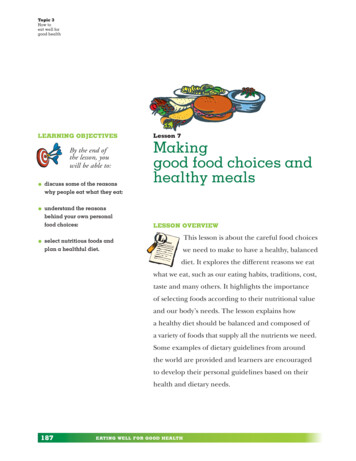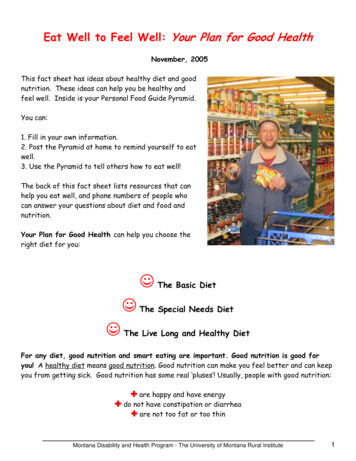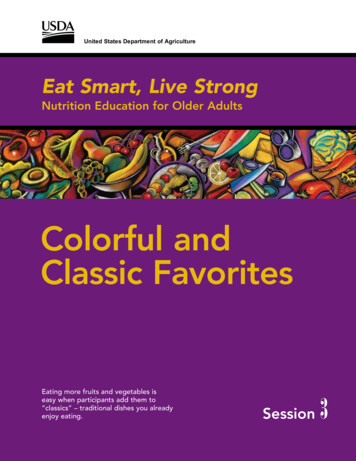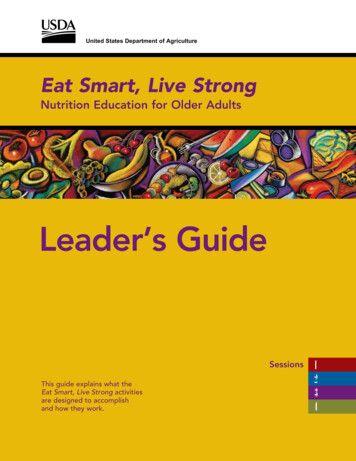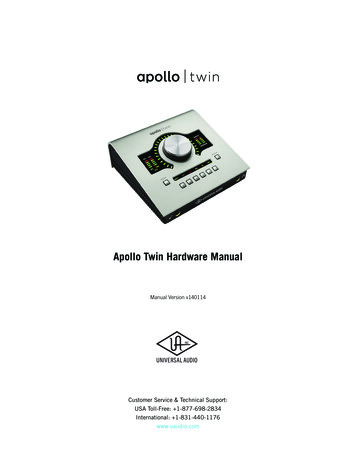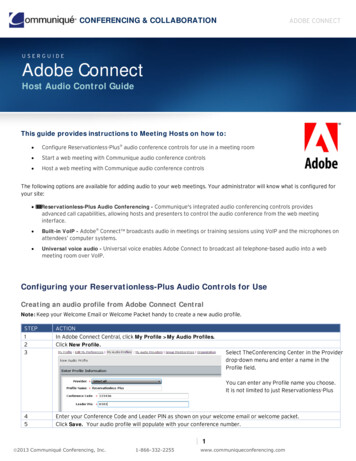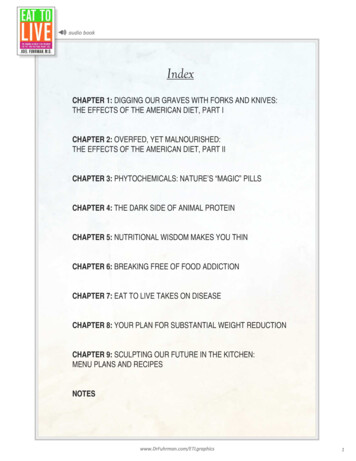
Transcription
IndexCHAPTER 1: DIGGING OUR GRAVES WITH FORKS AND KNIVES:THE EFFECTS OF THE AMERICAN DIET, PART ICHAPTER 2: OVERFED, YET MALNOURISHED:THE EFFECTS OF THE AMERICAN DIET, PART IICHAPTER 3: PHYTOCHEMICALS: NATURE’S “MAGIC” PILLSCHAPTER 4: THE DARK SIDE OF ANIMAL PROTEINCHAPTER 5: NUTRITIONAL WISDOM MAKES YOU THINCHAPTER 6: BREAKING FREE OF FOOD ADDICTIONCHAPTER 7: EAT TO LIVE TAKES ON DISEASECHAPTER 8: YOUR PLAN FOR SUBSTANTIAL WEIGHT REDUCTIONCHAPTER 9: SCULPTING OUR FUTURE IN THE KITCHEN:MENU PLANS AND RECIPESNOTES
1Digging Our Graves with Forks and KnivesTHE EFFECTS OF THE AMERICAN DIETCase Study:Robert lost over sixty pounds and saved his life!1
2Overfed, Yet MalnourishedTHE EFFECTS OF THE AMERICAN DIET, PART IICase Study:Charlotte lost 130 pounds and reversed her heart disease and diabetes!Compared with whole wheat, typical pasta and bread are missing: 62 percent of the zinc 72 percent of the magnesium 95 percent of the vitamin E 50 percent of the folic acid 72 percent of the chromium 78 percent of the vitamin B6 78 percent of the fiberRefined Foods Are Linked to: Oral cavity cancer Stomach cancer Colorectal cancer Intestinal cancer Breast cancer Thyroid cancer Respiratory tract cancer Diabetes Gallbladder disease Heart DiseaseLester Traband’s Yearly CheckupMy patient Les Traband came in for his yearly checkup. He was not overweightand had been following a vegetarian diet for years. I did a dietary review ofwhat he ate regularly. He was eating “healthy’ flaxseed waffles for breakfast,lots of pasta, whole wheat bread and vegan (no animal products) preparedfrozen meals on a regular basis.I spent about thirty minutes pointing out that he was certainly notfollowing my dietary recommendations for excellent health and presented himwith some menu suggestions and an outline of my nutritional prescription forsuperior health, which he agreed to follow.Twelve weeks later, he had lost about eight pounds and I recheckedhis lipid profile, because I didn't like the results we received from the blood testtaken the day of his checkup.The results speak for holestrol/HDL ratio230226551304.185/2/20011745778842.23
ANALYSIS OF ONE TABLESPOON OF OLIVE OIL Calories Fiber Protein Fat Saturated fat Minerals Vitamins120nonenone13.5 gm1.8 gmnone (trace, less than .01 mg of every mineralnone (trace of Vitamin E, less than 1 IU)
3Phytochemicals” Nature’s “Magic” PillsCase Study:Julia lost over one hundred pounds and has turned her life around!U.S. FOOD CONSUMPTIONBY CALORIES125.5%12.5%Refined and processed foodsDairy and animal foods62%Fruits, vegetables, beans, nuts,seeds, and whole grains13
THE MAJOR KILLERS OF AMERICANSPERCENT OF ALL DEATHS2Heart attacks, diabetes, and strokesAll Cancers402234
1. Phytochemicalsdetoxify and deactivatecancer-causing agentsand block the initiationprocess leading toDNA damage.Precanerous cellsMore DNA damage occurs and cancer develops5
USDA Food Guide Pyramid2-38-11Figure 1Figure 2
4The Dark Side of Animal ProteinCHOLESTEROL CONTENT INBEEF, TOP SIRLOINCHICKEN BREAST, NO SKIN1100 grams100 calories90 mg33 mg85 mg51 mg2Cancers Associated with Increased Consumption of Animal Products3Bladder CancerBrain CancerBreast CancerColon CancerEndomentrial CancerIntestional CancerKidney CancerLeukemiaLung CancerLymphomiaOropharyngeal cancerOvarian CancerPancreatic CancerProstate CancerSkin CancerStomach Cancer
4The Dark Side of Animal ProteinCalcium BalanceDietary Factors that Induce Calcium Loss in the Urine4Animal ProteinSaltCaffeineRefined SugarAlcoholNicotineAluminum-containing antacidsDrugs such as antibiotics, steroids, thyroid hormoneVitamin A supplements
5Nutritional Wisdom Makes You ThinCase Study:Can you imagine losing 333 pounds? Scott realized that bariatricsurgery was not a solution for him and, after much research,embraced Dr. Fuhrman’s Eat To Live diet.MORE BULK MEANS FEWER CALORIES
1A l p h a - l i n o l e n i c a c id( ei c o s p e n ta ei n o i c ac i d )( d o c o s ah e x a ei n o i c ac i d ))ss
Diabetes is only one of many diseases linked to excessive omega-6 fats.2THE FAT DICTIONARYAll fats are equally fattening—containing nine calories per gram, compared with four calories per gram forcarbohydrates and protein.ARACHIDONIC ACID is a long-chain omega-6 fat produced by the body, but it is also found in meat, fowl, dairy, andeggs. Products made with excessive amounts of this fatty acid have the potential to increaseinflammation and are disease-causing. They may increase high blood pressure, thrombosis, vasospasm, and allergicreaction. They are linked to arthritis, depression, and other common illnesses.CHOLESTEROL is a waxy fat produced by the body and found in animal foods such as meat, fowl, dairy,and eggs. Eating cholesterol raises blood cholesterol, but not as much as eating saturated fats and transfats. The amount of cholesterol in plants is so negligible that you should consider them cholesterol-free.DHA FAT is a long-chain omega-3 fat that is made by the body, but it can also be found in fish such as salmonand sardines. DHA is used in the production of anti-inflammatory mediators that inhibit abnormal immunefunction and prevent excessive blood clotting. DHA is not considered an essential fat because the body canmanufacture sufficient amounts if adequate short-chain omega-3 fats (flaxseed, walnuts, soybeans, leafy greenvegetables) are consumed. However, because of genetic differences in the enzyme activity and because ofexcess omega-6 fats, many people who do not consume fatty fish regularly are deficient in this important fat.HYDROgENATED FAT hydrogenation is a process of adding hydrogen molecules to unsaturated fats, therebyturning these oils, which are liquid at room temperature, into harder, more saturated fats such as margarine.Hardening the fat extends its shelf life so the oil can be used over and over again to fry potatoes in a fast-foodrestaurant or be added to processed foods such as crackers and cookies. While hydrogenation does not makethe fat completely saturated, it creates trans fatty acids, which act like saturated fats. Evidence is accumulatingto implicate the harmful nature of these man-made fats in both cancer and heart disease. Avoid all foods whoseingredients contain partially hydrogenated oils.MONOUNSATURATED FAT these fats have only one double bond in their carbon chain. They are liquid at roomtemperature and thought to have health benefits. The supposed health benefits of these fats appear when theyare used in place of dangerous saturated fats. But even polyunsaturated oils will lower cholesterol if used in placeof saturated fat. Monounsaturated fat is found in avocados, almonds, peanuts, and most other nuts and seeds.Keep in mind that no isolated or refined fat, even these monounsaturated fats, should be considered health food.Oils with the highest percentage of monounsaturated fat include olive, canola, and peanut oils.POLYUNSATURATED FAT These fatty acids have more than one double bond in their chain. These fats include cornoil, soybean oil, safflower oil, and sunflower oil. They are soft at room temperature. These fats promote the growth ofcancer in lab animals more than olive oil (a monounsaturated fat) does.SATURATED FAT some naturally occurring fats are called saturated because all of the bonds in their carbon chain aresingle bonds. These fats are solid at room temperature and are generally recognized as a significant cause of bothheart disease and cancer. Saturated fats are found mainly in meat, fowl, eggs, and dairy. Coconut and palm oil arelargely saturated and are not desirable. The foods with the most saturated fat are butter, cream, and cheese.UNSATURATED FAT These fats are a mix of monounsaturated and polyunsaturated fats. Eating unsaturated fatslowers choloesterol when substituted for saturated fats, but excessive amounts may promote cancer.
FISH WITH HIgHEST AND LOWEST MERCURY 37.04.818.014.09.016.018.05.85.4
6Breaking Free of Food AddictionCase Study:Isabel lost eighty pounds and has kept it off for over four years!Symptoms of Toxic Hunger headachesfatiguenauseaweaknessmental confusion and irritabilityabdominal and esophageal spasmfluttering and cramping in the stomachThe Blood Sugar CurvegluconeogenesisSymptoms of True HungerEnhanced taste sensationIncreased salivationGnawing throat sensation
How to Achieve a State of True Hunger1. Do not eat when not hungry.2. Do not snack, unless you are sure it is true hunger.3. Do not overeat. Don’t eat until you feel full or stuffed.4. Do not eat a big dinner.5. Don’t eat after dinner. Instead, clean the kitchen, brush and floss, and stayaway from food. Look forward to how good food will taste the next morningwhen you are hungry again.6. Discontinue or wean off caffeine, salt, alcohol, sweets, butter, cheese,processed foods, soft drinks, smoking, and illegal and legal drugs (if safe todo so).What if Americans: ate a large bowl of green salad dailyhad a large serving of steamed greens dailyate a cup of beans dailyhad at least on ounce of raw seeds and nuts dailyate at least three fresh fruits dailyhad some tomatoes, peppers, onions, mushrooms, herbs, and garlic daily
7Eat To Live Takes on DiseaseCase Study:Ronnie was in a downward spiral of unhealthy eating, binge drinking,and depression. He started Eat To Live and gained a new life!was as followsAfter a year ofTotal CholesterolDietary-Caused Illnesses with High Prevalenceacneappendicitisatherosclerosisdiabetes (adult)fibromyalgiagouthigh blood pressureirritable bowel syndromemacular degenerationsexual dysfunctionallergiesarthritiscolonic c symptomskidney stonesmusculoskeletal itishemorrhoidsindigestionlumbar spine syndromeosteoporosisuterine fibroids
Quick Quiz: Heart Disease1. Percentage of children between the ages of four and eleven who already have signs of heartdisease?1A. NoneB. 10 percentC. 40 percentD. More than 75 percent2. Percentage of female heart attack victims who never knew they had heart disease and thendie as a result of their first heart attack?2A. NoneB. 10 percentC. 25 percentD. More than 75 percent3. Percentage of heart disease patients who undergo angioplasty and then have their treatedarteries clog right back up again within six months?3A. 5 percentB. 10 percentC. 25 percentD. none of the aboveAnswers: 1.D 2.C 3.CWARNINg: Do not merely comply with these overly permissive recommendationsof the American Heart Association, or you will most likely die of a heart attack Total fat intake should be restricted to 25 to 35 percent of total calories Cholesterol intake should be less than 300 mg daily. Salt intake should not exceed 1,500 mg of sodium daily.Case Study: Cliff JohnstonCliff is a chiropractic physician. His father died of heart disease at age forty-seven. Cliff is nowforty-five years old. Guess what he was headed for? Luckily, he became my patient and was ableto get appropriate advice in 9853031369/11/96% CHANgE170975589-58-95-82-35The GGT is a parameter of liver function, and the elevated level reflected a degree of fatty infiltration inthe liver, negatively affecting its function. The elevated glucose showed the beginning of diabetes. Both wereresolved when I placed him on an appropriate diet.I had originally asked him to wait two months to have his blood redrawn, but he was so enthusiasticand feeling so great because his weight went from 206 to 178 in the one-month period that he came backfour weeks early. Can you imagine losing twenty-eight pounds in one month while eating as much food asyou like? This is a lot of weight to lose in one month, and is not typical.
JOHN’S LABORATORY erol:HDL ratio5/5/99218140481444.7% CHANgE1618065802.4-26-4335-44-4915 COMMON MIGRAINE TRIGGERSsweetsmonosodium glutamatechocolatehydrolyzed proteinfood additivesfermented foodsyeastsmoked meatssalted or pickled foodsbaked goodspizzadairy and cheesenutsvinegaralcoholPhase one Anti-headache Diet with a greaterThan 90 Percent Cure RateBreakfastMelon, apple, or pearOatmeal and water, no sweetenerYeast-free whole grain breadLunchLarge green salad, with one teaspoon of olive oilOne starchy vegetable or grain—corn, sweet potato, brown riceGrapes, pear, or appleDinnerLarge green salad with tomatoes, with one teaspoon of olive oilOne steamed green vegetable—string beans, asparagus, artichokes,broccoli, zucchiniOne starchy vegetable or grain—butternut or acorn squash, potato,millet, whole wheat pastaTomato sauce (unsalted) permitted
8Your Plan for Substantial Weight ReductionCase Study:Emily lost one hundred pounds and took years off her body.In just two months, her blood pressure and cholesterolstats reflected healthy numbers.EAT TO LIVEThe Six-Week PlanUNLIMITEDEat as much as you want:all raw vegetables (goal: 1 lb. daily)cooked green and non-green nutrient-rich vegetables (goal: 1 lb. daily; non-green nutrient-richvegetables are eggplant, mushrooms, peppers, onions, tomatoes, carrots, cauliflower)beans, legumes, bean sprouts, and tofu (goal: 1 cup daily)fresh fruits (at least 4 daily)LIMITEDCooked starchy vegetables or whole grains:butternut and acorn squash, corn, white potatoes, rice, sweet potatoes, bread, cereal (not morethan one serving, or 1 cup, per day)raw nuts and seeds (1 oz. max. per day)avocado (2 oz. max. per day)dried fruit (2 tablespoons max. per day)ground flaxseeds (1 tablespoon max. per day)OFF-LIMITSdairy productsanimal productsbetween-meal snacksfruit juiceoils
Simplify, Simplify, SimplifyBreakfast: fresh fruitLunch: salad, beans on top, and more fruitDinner: salad and two cooked vegetables (1 lb.), fruit dessert100 Calories of Low-Nutrient Foods Equals: 2½ teaspoons of olive oil ½ bagel ½ cup of pasta 1 small cookie 2 ounces of broiled chicken or turkey breast 3 ounces of fish 1½ ounces of red meat 1 thin slice of cheese 1 cup of 1 percent or skim milkDr. Fuhrman’s Nutritarian Food Pyramid
9Sculpting Our Future in the KitchenCase Study:Anthony lost 160 pounds, lowered his blood pressure,and no longer experiences migraines.Weekly Shopping ListAlways keep a good assortment of healthy food in the house. A key to success is having the right kind of food available to prevent being tempted bythe wrong kind of food. I suggest the following items.vegetables to be eaten raw—carrots, celery, peppers, tomatoes, cucumbers, mushrooms, lettuce and other salad greens, snow peas, sugar snappeas, tomatoes.vegetables for cooking—broccoli, cauliflower, eggplant, mushrooms, eggplant, tomatoes, cabbage, string beans, kale, swiss chard, mustard greens,spinach, Brussels sprouts, asparagus, onions, garlic.Fruits (fresh or frozen)— strawberries, blueberries, raspberries, kiwis, apples,oranges, pineapple, melons, lemons, limes, grapes, pears, bananas, mangos,plums, peaches and cherries.Raw nuts and seeds— walnuts, almonds, cashews, pistachios, sunflowerseeds, pumpkin seeds, unhulled sesame seeds, hemp seeds, flaxseed, andchia seeds.Ingredients for homemade soups—carrots, celery, garlic, onions, zucchini,fresh and dried herbs, no salt seasoning, leeks, turnips, dried beans, lentilsand split peas.Other staples—flavored and balsamic vinegars, lemons (juice is great insalad, soup, or vegetable dish), tomato sauce (no salt added), salsa (no saltadded), avocados, tofu, edamame (green soybeans), and old-fashionedrolled oats.Fresh or dried herbs/seasonings— basil, oregano, dill, parsley, cilantro,chives, rosemary, thyme, ginger, garlic cloves or garlic powder, onion powder, mint,chili powder, cumin, Cajun seasoning, pepper, curry powder, cinnamon, Mrs. Dash,Dr. Fuhrman’s VegiZest or MatoZest.
NotesChapter 11Clinical guidelines on the identification,evaluation, and treatment of overweight and obesity in adults. 1998. National Heart, Lung,and Blood Institute reprint. Bethesda, Md.: National In- stitutes of Health.Chapter 31Williams CD, Satia JA, Adair LS, et al. Dietary patterns, food groups, and rectal cancer risk in Whites and African-Americans.Cancer Epidemiol Biomarkers Prev. 2009 May;18(5):1552-61.Flood A, Rastogi T, Wirfält E, et al. Dietary patterns as identified byfactor analysis and colorectal cancer among middle-aged Americans. Am J Clin Nutr. 2008 Jul;88(1):176-84.2Heron M, Tejada-Vera B. Deaths: Leading Causes for 2005. National Vital Statistics Reports. Volume 58, Number 8, December23, 2009. U.S. Centers for Disease Control. http://www.cdc.gov/nchs/data/nvsr/nvsr58/nvsr58 08.pdf3USDA Economic Research Service. Loss-adjusted food umption/FoodGuideIndex.htm4Original chart: data compiled from 1960’s mortality data from the World Health Organization and National Institutes of health(no longer available online), food balance sheets from the Food and Agriculture Organization of the United Nations r), and communication with health authorities in several of the countries listed.5Nutritionist Pro Nutrition Anaylsis Software, Versions 2.5, 3.1, Axxya Systems, Stafford TX, 2006. Based on USDA standard reference data for cooked frozen broccoli, broiled porterhouse steak, chopped romaine lettuce, and boiled kale.Chapter 41U.S. Department of Agriculture. Agricultural Research Service. 1999. USDA nutrient database for standard reference, release 13. Nutrient Data Laboratory home page, www. nal.usda.gov/fnic/foodcomp.2Tanner JM. Trend toward earlier menarche in London, Oslo, Copenhagen, the Netherlands and Hungary. Nature 1973;243:75-76.3Fraser GE. Association between diet and cancer, ischemic heart disease, and all-cause mortality in non-Hispanic white California Seventh-Day Adventists. Am J Clin Nutr 1999;70(3 supp.):532-38S.Sarasua S, Savitz DA. Cured and broiled meat consump- tion in relation to childhood cancer. Cancer Causes Control 1994;5(2):141-48.Favero A, Parpinel M, Franceschi S. Diet and risk of breast cancer: major findings from an Italian case-control study. Biomed Pharmacother 1998;52(3):109-15.Levi F, Pasche C, La Vecchia C, Lucchini F, Franceschi S. Food groups and colorectal cancer risk. Br J Cancer 1999;79(7-8):1283-87.Steinmetz KA, Potter JD. Food-group consumption and colon cancer in the Adelaide Case-Control Study: meat, poultry, seafood, dairyfoods and eggs. Int J Cancer 1993;53(5):720-27. Levi F, Franceschi S, Negri E, La Vecchia C. Dietary factors and the risk of endometrialcancer. Cancer 1993;71(11):3575-81.Negri E, Bosetti C, La Vecchia C, et al. Risk factors for adenocarcinoma of the small intestine. Int J Cancer 1999;82 (2): 171-74.Chow WH, Gridley G, McLoughlin JK, et al. Protein intake and risk of renal cell cancer. J. Nat. Cancer Inst. 1994;86: 1131-39.Kwiatkowski A. Dietary and other environmental risk factors in acute leukemias: a case- control study of 119 patients. Eur J Cancer Prev1993;2(2):139-46.National Institutes of Health, National Cancer Institute. 1996. Cancer rates and risks: cancer death rates among 50 countries (age adjusted to the world standard), 4th ed. U.S. Department of Health and Human Services. Lung cancer, p. 39. Source: World Health Organization data as adapted by the American Cancer Society.Deneo- Pelligrini H, De Stefani E, Ronco A, et al. Meat consumption and risk of lung cancer; a case- control study from Uruguay. LungCancer 1996;14 (2-3):195-205.Zhang S, Hunter DJ, Rosner BA, et al. Greater intake of meats and fats associated with higher risk of non-Hodgkins lymphoma. J NatCancer Inst 1999;91(20):1751-58.Cunningham AS. Lymphomas and animal-protein consumption. Lancet 1976;27:1184-86. Franceschi S, Favero A, Conti E, et al. Foodgroups, oils and butter, and cancer of the oral cavity and pharynx. Br J Cancer 1999;80(3-4):614-20.Tominaga S, Aoki K, Fujimoto I, et al. Cancer mortality and morbidity sta- tistics. Japan and the World. Boca Raton, Fla.: Japan ScientificSoci- eties Press, CRC Press, 1994;196.Soler M, Chatenoud L, La Vecchia C, et al. Diet alcohol, coffee and pancreatic can- cer: final results from an Italian study. Eur J CancerPrev 1998;7(6):455-60.Sung JF, Lin RS, Pu YS, et al. Cancer 1999;86 (3):484-91.Black HS, Herd JA, Goldberg LH, et al. Effect of a low-fat diet on the incidence of actinic keratosis. New Eng J Med. 1994;330: 1272-75.4Kerstetter JE, Wall DE, O'Brien KO, et al. Meat and soy protein affect calcium homeostasis in healthy women. J Nutr. 2006Jul;136(7):1890-5.Massey LK. Dietary Animal and Plant Protein and Human Bone Health: A Whole Foods Approach. J Nutr. 2003 Mar;133(3):862S865S.Nowson CA, Patchett A, Wattanapenpaiboon N. The effects of a low-sodium base-producing diet including red meat comparedwith a high-carbohydrate, low-fat diet on bone turnover markers in women aged 45-75 years. Br J Nutr. 2009 Oct;102(8):1161-70.Teucher B, Dainty JR, Spinks CA. Sodium and bone health: impact of moderately high and low salt intakes on calcium metabolismin postmenopausal women. J Bone Miner Res. 2008 Sep;23(9):1477-85.Siener R, Schade N, Nicolay C, et al. The efficacy of dietary intervention on urinary risk factors for stone formation in recurrent calcium oxalate stone patients. J Urol. 2005 May;173(5):1601-5.Yildirim ZK, Büyükavci M, Eren S, et al. Late side effects of high-dose steroid therapy on skeletal system in children with idiopathicthrombocytopenic purpura. J Pediatr Hematol Oncol. 2008 Oct;30(10):749-53.Karner I, Hrgović Z, Sijanović S, et al. Bone mineral density changes and bone turnover in thyroid carcinoma patients treated withsupraphysiologic doses of thyroxine. Eur J Med Res. 2005 Nov 16;10(11):480-8.Lim LS, Harnack LJ, Lazovich D, Folsom AR. Vitamin A intake and the risk of hip fracture in postmenopausal women: the IowaWomen's Health Study. Osteoporos Int. 2004 Jul;15(7):552-9.Caire-Juvera G, Ritenbaugh C, Wactawski-Wende J, et al. Vitamin A and retinol intakes and the risk of fractures among participantsof the Women's Health Initiative Observational Study. Am J Clin Nutr. 2009 Jan;89(1):323-30.Massey LK, Whiting SJ. Caffeine, urinary cal- cium, calcium metabolism and bone. J. Nutr. 123 (9): 1611-14; Harris, S. S., and B.Dawson-Hughes. 1994. Caffeine and bone loss in healthy postmenopausal women. Am J Clin Nutr 1993;60(4):573-78.Nguyen NU, Dumoulin G, Wolf JP, Berthelay S. Urinary calcium and oxalate excretion during oral fructose or glucose load inman. Horm Metab Res 1989;21(2):96-99.Sampson HW. Alcohol, osteoporosis, and bone regulating hormones. Alcohol Clin Exp Res 1997;21(3):400-03.Wolinsky-Friedland M. Drug-induced metabolic bone disease. Endocrinol Metab Clin North Am 1995;24 (2): 395-420.Melhus H, Michaelson K, Kindmark A, et al. Excessive dietary intake of vitamin A is associated with reduced bone mineraldensity and increased risk of hip fracture. Ann Intern Med 1998;129(10):770-78
Chapter 5Mangels, A. R., J. M. Holden, G. R. Beecher, et al. 1993. Carotenoid content of fruits and vegetables: an evaluation of analytic data.J. Am. Diet. Assoc. 93 (3): 284-96.1Simopoulos AP Essential fatty acids in health and chronic disease. Am J Clin Nutr 1999;70 (3): 560-69.2Mercury Levels in Commercial Fish and ontaminants/methylmercury/ucm115644.htm.3Chapter 71Berenson G. S., W. A. Wattigney, W. Bao, S. R. Srinivasan, and B. Radha- krishnamurthy. 1995. Rationale to study theearly natural history of heart disease: the Bogalusa Heart Study. Am. J. Med. Sci. 310 (S1): S22-28.1Marrugat J, Sala J, Masia R, et al. Mortality differences between men and women following first myocardial infarction. JAMA1998;280:1405-09.3Hanekamp C, Koolen J, Bonnier H, et al. Randomized comparison of balloon angioplasty versus silicon carbon-coated stent implantation for de novo lesions in small coronary arteries. Am J Cardiol. 2004 May 15;93(10):1233-7.
1. Do not eat when not hungry. 2. Do not snack, unless you are sure it is true hunger. 3. Do not overeat. Don’t eat until you feel full or stuffed. 4. Do not eat a big dinner. 5. Don’t eat after dinner. Instead, clean the kitchen, brush and floss, and stay away from food.
